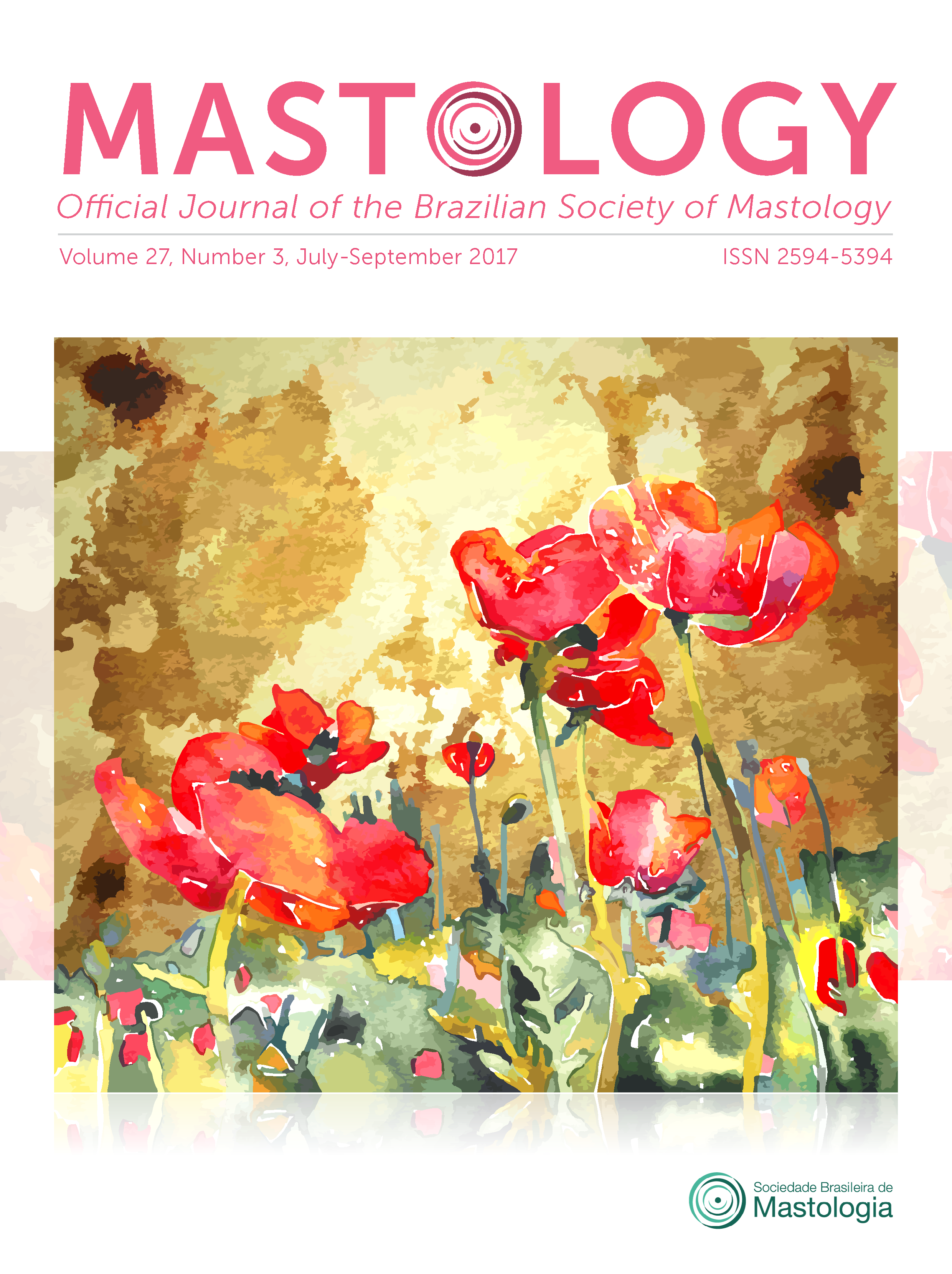IMPACT OF THE PINK OCTOBER IN THE MAMMOGRAPHIC SCREENING ADHERENCE IN A REFERENCE CENTER IN ONCOLOGY
Keywords:
Mammography, breast neoplasms, health promotion, mass screening, early diagnosisAbstract
Objective: To analyze the impact of Pink October in the mammographic screening adherence in a reference center in oncology. Methods: This is a cross-sectional, descriptive and retrospective study of a population of women who underwent mammographic screening in the years 2014, 2015 and 2016. Mammography reports were used for data collection. Comparing the months of October with the other months of the studied years, we observed if there were changes in the number of mammograms and in the proportion of mammograms Breast Imaging Reporting and Data System (BI-RADS) 3, 4 and 5. To verify statistical significance, the Z-score (95% confidence interval — CI95%) and the χ2 test (p<0.05) were used. Results: 105,698 mammograms were performed. There was a significant difference in the number of mammograms performed in October compared to the other months of the study. In addition, there was an absolute increase in the number of mammograms BI-RADS 3, 4 and 5; however, their proportion in the months of October did not presented difference in comparison to the other months. Conclusion: Population-based campaigns to prevent breast cancer appear to be effective in increase of demand for mammographic screening, possibly leading to an increase in the number of cancers discovered, allowing more women to receive timely treatment.
Downloads
References
Tiezzi DG. Epidemiologia do câncer de mama. Rev Bras Ginecol Obstet. 2009;31(5):213-5.
Brasil. Ministério da Saúde. Instituto Nacional de Câncer José Alencar Gomes da Silva. Estimativa 2016: incidência de câncer no Brasil [Internet]. 2016 [cited on 2017 Mar 6]. Available from: http://www.inca.gov.br/estimativa/2016/estimativa-2016-v11.pdf
Morrell S, Taylor R, Roder D, Robson B, Gregory M, Craig K. Mammography service screening and breast cancer mortality in New Zealand: a National Cohort Study 1999-2011. Br J Cancer. 2017. doi: 10.1038/bjc.2017.6
Höfelmann DA, Anjos JC, Ayala AL. Sobrevida em dez anos e fatores prognósticos em mulheres com câncer de mama em Joinville, Santa Catarina, Brasil. Ciên Saúde Colet. 2014;19(6):1813-24.
Chen HH, Yen AMF, Fann JCY, Gordon P, Chen SLS, SYH Chiu, et al. Clarifying the debate on population-based screening for breast cancer with mammography: a systematic review of randomized controlled trials on mammography with Bayesian meta-analysis and causal model. Medicine [Internet]. Jan 2017 [cited on 2017 Mar 6];96(3):e5684. Available from: http://journals.lww.com/md-journal/Fulltext/2017/01200/Clarifying_the_debate_on_population_based.4.aspx
Brasil. Ministério da Saúde. Instituto Nacional de Câncer José Alencar Gomes da Silva. Diretrizes para a detecção precoce do câncer de mama no Brasil [Internet]. 2015 [cited 2017 Mar 06]. Available from: http://www1.inca.gov.br/inca/Arquivos/livro_deteccao_precoce_final.pdf
Urban LABD, Schaefer MB, Duarte DL, Santos RP, Maranhão NMA, Kefalas AL, et al. Recomendações do Colégio Brasileiro de Radiologia e Diagnóstico por Imagem, da Sociedade Brasileira de Mastologia e da Federação Brasileira das Associações de Ginecologia e Obstetrícia para rastreamento do câncer de mama por métodos de imagem. Radiol Bras. 2012;45(6):334-9.
Wernli KJ, Arao RF, Hubbard RA, Sprague BL, Alford-Teaster J, Haas JS, et al. Change in Breast Cancer Screening Intervals Since the 2009 USPSTF Guideline. J Womens Health. 2017. DOI: 10.1089/jwh.2016.6076
Oliveira EXG, Pinheiro RS, Melo ECP, Carvalho MS. Condicionantes socioeconômicos e geográficos do acesso à mamografia no Brasil, 2003-2008. Ciênc Saúde Colet. 2011;16(9):3649-64.
Maria FLC, Matos DL. Prevalência e fatores associados à realização da mamografia na faixa etária de 50-69 anos: um estudo baseado na Pesquisa Nacional por Amostra de Domicílios (2003). Cad Saúde Pública. 2007;23(7);1665-73.
Instituto Neo Mama de Prevenção e Combate ao Câncer de Mama. História do Outubro Rosa [Internet]. [cited on 2016 Oct 10]. Available from: http://outubrorosa.org.br/historia/
Sickles EA, D’Orsi CJ, Bassett LW, Mendelson EB, Morris EA. ACR BI-RADS® Mammography. In: ACR BI-RADS® Atlas. Breast Imaging Reporting and Data System. Reston, VA: American College of Radiology; 2013.
Brasil. Ministério da Saúde. Instituto Nacional de Câncer José Alencar Gomes da Silva. Mamografia: da prática ao controle [Internet]. 2007 [cited on 2017 Mar 6]. Available from: http://www.inca.gov.br/inca/Arquivos/publicacoes/qualidade_em_mamografia.pdf
Tomazelli JG, Migowski A, Ribeiro CM, Assis M, Abreu DMF. Avaliação das ações de detecção precoce do câncer de mama no Brasil por meio de indicadores de processo: estudo descritivo com dados do Sismama, 2010-2011. Epidemiol Serv Saúde. 2017;26(1):61-70.
Badan GM, Roveda Júnior D, Ferreira CAP, Noronha Júnior OA. Complete internal audit of a mammography service in a reference institution for breast imaging. Radiol Bras. 2014;47(2):74-8.
Rodrigues DCN, Freitas-Junior R, Corrêa RS, Peixoto JE, Tomazelli JG, Rahal RMS. Avaliação do desempenho
dos centros de diagnóstico na classificação dos laudos mamográficos em rastreamento oportunista do Sistema Único de Saúde (SUS). Radiol Bras. 2013;46(3):149-55.
Migowski A. Riscos e benefícios do rastreamento do câncer de mama no Brasil. Ciênc Saúde Colet. 2016;21(3):989.
Redondo A, Comas M, Macià F, Ferrer F, Murta-Nascimento C, Maristany MT, et al. Inter- and intraradiologist variability in the BI-RADS assessment and breast density categories for screening mammograms. Br J Radiol. 2012;85:1465-70.
Grimm LJ, Anderson AL, Baker JA, Johnson KS, Walsh R, Yoon SC, et al. Interobserver variability between breast imagers using the fifth edition of the BI-RADS MRI Lexicon. AJR Am J Roentgenol. 2015;204(5):1120-4.
Calas MJG, Almeida RMVR, Gutfilen B, Pereira WCA. Interobserver concordance in the BI-RADS classification of breast ultrasound exams. Clinics. 2012;67(2):185-9.
Downloads
Published
How to Cite
Issue
Section
License
Copyright (c) 2017 Douglas Soltau Gomes, Poliana Ruhmke Vazzoller, Yuri Costa Farago Fernandes, Bruna Aparecida Gotardo, Jocelito Ruhnke

This work is licensed under a Creative Commons Attribution 4.0 International License.







